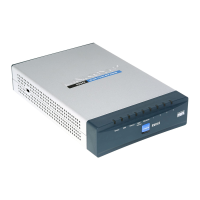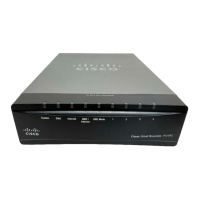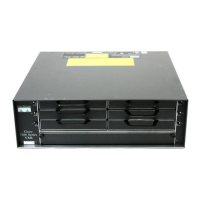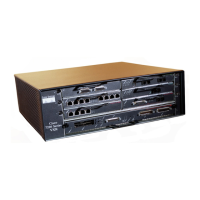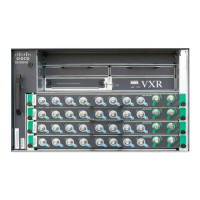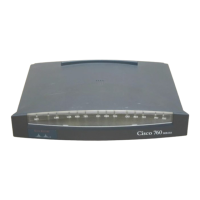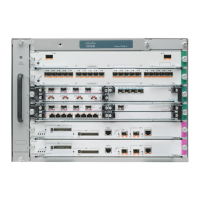2-7
Cisco 7200 VXR Installation and Configuration Guide
OL-5013-09
Chapter 2 Preparing for Installation
Site Requirement Guidelines
When planning your rack installation, consider the following guidelines:
• If you plan to use an equipment shelf, ensure that the shelf is constructed to support the weight and
dimensions of the chassis.
Figure 2-2 shows the chassis footprint, which you need if you are
designing a customized shelf. We recommend that you use the rack-mount kit designed for
Cisco
7200 VXR routers.
Caution To prevent chassis overheating, never install the Cisco 7200 VXR in an enclosed rack or room that is not
properly ventilated or air-conditioned.
• Allow sufficient clearance around the rack for maintenance. If the rack is mobile, you can push it
back near a wall or cabinet for normal operation and pull it out for maintenance (installing or moving
port adapters, connecting cables, or replacing or upgrading components). Otherwise, allow 19
inches (48.3 cm) of clearance to remove Cisco
7200 VXR FRUs.
• If you are planning to install the cable-management brackets on a Cisco 7200 VXR router that you
are rack-mounting from the front, you must install the cable-management brackets and the
rack-mount brackets before you install the chassis in the rack.
• Provide an adequate chassis ground (earth) connection for your router chassis.
Note We strongly recommend that you provide a chassis ground connection. See the “Attaching a Chassis
Ground Connection” section on page 3-17 in Chapter 3, “Installing a Cisco 7200 VXR Router” for
instructions.
To properly install a Cisco 7200 VXR chassis in a rack, see the instructions in the “Rack-Mounting a
Cisco 7200 VXR Router” section on page 3-2 in Chapter 3, “Installing a Cisco 7200 VXR Router.”
Temperature and Humidity Requirements
Table 2-1 lists the operating and nonoperating environmental site requirements. The ranges listed are
those within which the Cisco 7200 VXR routers continue to operate; however, a measurement that is
approaching the minimum or maximum of a range indicates a potential problem. You can maintain
normal operation by anticipating and correcting environmental anomalies before they approach a
maximum operating range.
Ta b l e 2-1 Specifications for Operating and Nonoperating Environments
Specification Minimum Maximum
Temperature, ambient operating 32•F (0•C) F (0•C) 104•F (40•C)F (40•C)
Temperature, ambient nonoperating and storage –4•F (–20•C) F (–20•C) 149•F (65•C)F (65•C)
Humidity, ambient (noncondensing) operating 10% 90%
Humidity, ambient (noncondensing) nonoperating
and storage
5% 95%
Altitude, operating, and nonoperating Sea level 6,500 ft.
(2000 m)
Vibration, operating 5–200 Hz, 0.5 g (1 octet/min.) —
Vibration, nonoperating 5–200 Hz, 1 g (1 octet/min.)
200–500
Hz, 2 g (1 octet/min.)
—

